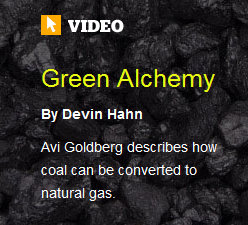Getting the Dirt Out
A new and improved way to turn coal into clean fuel.
BU Alums hope to make the world a greener place.
 5 Ways to get there.
5 Ways to get there.
by Art Jahnke
http://www.bu.edu/bostonia/fall10/green/

Just beyond the great cylindrical cooling towers of the Brayton Point Power Station on Rhode Island’s Narragansett Bay, a shorter, square tower rises above a metal-sided industrial building. In the shadow of Brayton, the largest coal burning plant in New England, it looks like a baby power plant. And while a commercial version of the GreatPoint pilot gas production facility may someday match the height and megawattage of its imposing neighbor, it will have a very different, much cleaner mission. Rather than burn coal to produce energy, the GreatPoint facility converts even the dirtiest coal to one of the cleanest fuels around: natural gas.
“It’s clean,” says Avi Goldberg (CGS’96, CAS’98), cofounder and chief operating officer of GreatPoint Energy, “because we convert it into gas, and in doing so we can strip out the pollutants.”
Scientists have been turning coal into synthetic fuel for nearly a century, and synfuel, as the product is known, is produced commercially all over the world. What’s new (and improved) about GreatPoint’s process, says Goldberg, is the use of a secret catalyst to optimize the conversion and allow it to turn coal, coke, and other carbon-based fuel into pipeline-quality natural gas. That’s the kind of gas that provides 25 percent of the energy consumed in the United States and heats 60 percent of homes, according to Goldberg. He says the company’s hydromethanation process can do that at a price that works in today’s economy. What’s more, the GreatPoint process allows for capture of the carbon dioxide by-product.
“That’s important,” he says, “because you can take the carbon dioxide and use it to repressurize oil fields and extract more oil from abandoned wells.”
Goldberg cofounded GreatPoint with company CEO Andrew Perlman (CAS’98). They met in 1997, and when Goldberg graduated with a degree in political science, he went to work for Perlman, who had left school to start a voice-over data company that would become Cignal Global Communications.
“When I started, we had 10 people,” says Perlman. “We went from 10 to 300 people in 22 countries.”
In 2000, Cignal was sold to a large European data company, and the two young entrepreneurs immediately started a new company, Coatue Semiconductors, which was sold after two years to Advanced Micro Devices. Together, the former roommates and partners in GreatPoint Ventures, which Goldberg calls a “venture creation company,” have started nine companies, including six that work with green energy.
“We started looking into green energy in 2001,” recalls Perlman. “We entered the space in 2005 when we started raising money for GreatPoint. We both felt that we wanted to do something that would really make people’s lives better.”
For GreatPoint Energy alone, Goldberg and Perlman have raised $150 million from investors, including Dow Chemical Company and Suncor Energy, as well as venture capital firms such as Advanced Technology Ventures and Citi’s Sustainable Development Investments.
The pilot plant on Narragansett Bay has now conducted at least a dozen successful trials, and Goldberg is convinced that his technology is good to go. The next step, he says, is building the commercial-scale plant. He says that GreatPoint is scouting locations, and he hopes to build near coal mines, to reduce the cost of transporting coal, and near oil refineries, which produce petroleum coke.
____________________

1 comment
Dear Bostonia,
Brayton Point is in Somerset, Mass, not RI, though Narragansett Bay borders both states.
Prof. Susan Lee, CGS